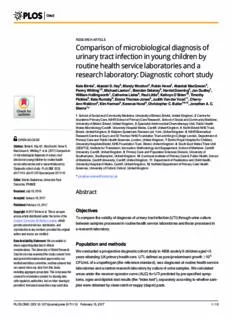
Comparison of microbiological diagnosis of urinary tract infection in young children by routine PDF
Preview Comparison of microbiological diagnosis of urinary tract infection in young children by routine
RESEARCHARTICLE Comparison of microbiological diagnosis of urinary tract infection in young children by routine health service laboratories and a research laboratory: Diagnostic cohort study KateBirnie1,AlastairD.Hay2,MandyWootton3,RobinHowe3,AlasdairMacGowan4, PennyWhiting1,5,MichaelLawton1,BrendanDelaney6,HarrietDowning2,JanDudley7, WilliamHollingworth1,CatherineLisles8,PaulLittle9,KathrynO’Brien10,Timothy a1111111111 Pickles8,KateRumsby9,EmmaThomas-Jones8,JudithVanderVoort11,Cherry- a1111111111 AnnWaldron8,KimHarman9,KerenzaHood8,ChristopherC.Butler10,12,JonathanA.C. a1111111111 Sterne1* a1111111111 a1111111111 1 SchoolofSocialandCommunityMedicine,UniversityofBristol,Bristol,UnitedKingdom,2 Centrefor AcademicPrimaryCare,NIHRSchoolofPrimaryCareResearch,SchoolofSocialandCommunityMedicine, UniversityofBristol,Bristol,UnitedKingdom,3 SpecialistAntimicrobialChemotherapyUnit,PublicHealth WalesMicrobiologyCardiff,UniversityHospitalWales,Cardiff,UnitedKingdom,4 NorthBristolNHSTrust, Bristol,UnitedKingdom,5 KleijnenSystematicReviewsLtd,York,UnitedKingdom,6 NIHRBiomedical ResearchCentreatGuy’sandStThomas’NHSFoundationTrustandKing’sCollegeLondon,Departmentof OPENACCESS PrimaryCareandPublicHealthSciences,London,UnitedKingdom,7 BristolRoyalHospitalforChildren, UniversityHospitalsBristol,NHSFoundationTrust,Bristol,UnitedKingdom,8 SouthEastWalesTrialsUnit Citation:BirnieK,HayAD,WoottonM,HoweR, (SEWTU),InstituteforTranslation,Innovation,MethodologyandEngagement,SchoolofMedicine,Cardiff MacGowanA,WhitingP,etal.(2017)Comparison University,Cardiff,UnitedKingdom,9 PrimaryCareandPopulationSciencesDivision,Universityof ofmicrobiologicaldiagnosisofurinarytract Southampton,Southampton,UnitedKingdom,10 CochraneInstituteofPrimaryCare&PublicHealth,School infectioninyoungchildrenbyroutinehealth ofMedicine,CardiffUniversity,Cardiff,UnitedKingdom,11 DepartmentofPaediatricsandChildHealth, servicelaboratoriesandaresearchlaboratory: UniversityHospitalofWales,Cardiff,UnitedKingdom,12 NuffieldDepartmentofPrimaryCareHealth Diagnosticcohortstudy.PLoSONE12(2): Sciences,UniversityofOxford,Oxford,UnitedKingdom e0171113.doi:10.1371/journal.pone.0171113 *[email protected] Editor:MartinChalumeau,UniversiteParis Descartes,FRANCE Received:July19,2016 Abstract Accepted:January16,2017 Published:February15,2017 Objectives Copyright:©2017Birnieetal.Thisisanopen accessarticledistributedunderthetermsofthe Tocomparethevalidityofdiagnosisofurinarytractinfection(UTI)throughurineculture CreativeCommonsAttributionLicense,which betweensamplesprocessedinroutinehealthservicelaboratoriesandthoseprocessedin permitsunrestricteduse,distribution,and reproductioninanymedium,providedtheoriginal aresearchlaboratory. authorandsourcearecredited. DataAvailabilityStatement:Weareunableto Populationandmethods sharesupportingdataduetoethical considerations.TheUniversityofBristolResearch Weconductedaprospectivediagnosticcohortstudyin4808acutelyillchildrenaged<5 DataServicehasexaminedthestudyconsentform yearsattendingUKprimaryhealthcare.UTI,definedaspure/predominantgrowth(cid:21)105 andparentinformationsheetapprovedbyour institutionalethicscommittee,andhasadvisedthat CFU/mLofauropathogen(thereferencestandard),wasdiagnosedatroutinehealthservice wecannotshareanydatafromthisstudy, laboratoriesandacentralresearchlaboratorybycultureofurinesamples.Wecalculated includingaggregategroupdata.Thisisbecausethe areasunderthereceiver-operatorcurve(AUC)forUTIpredictedbypre-specifiedsymp- consentformincludesconsentforsharingdata toms,signsanddipsticktestresults(the“indextest”),separatelyaccordingtowhethersam- withregulatoryauthorities,butnoothersharingis permitted.Interestedresearchersmaysenddata pleswereobtainedbycleancatchornappy(diaper)pads. PLOSONE|DOI:10.1371/journal.pone.0171113 February15,2017 1/13 ComparisonoflaboratoryperformanceinthediagnosisofUTIinyoungchildren requestsandqueriesto:SouthWestCentralBristol Results ResearchEthicsCommittee+44(0)2071048028 251(5.2%)and88(1.8%)childrenwereclassifiedasUTIpositivebyhealthserviceand [email protected]. UniversityofBristolResearchDataService+44(0) researchlaboratoriesrespectively.Agreementbetweenlaboratorieswasmoderate(kappa= [email protected]. 0.36;95%confidenceinterval[CI]0.29,0.43),andbetterforcleancatch(0.54;0.45,0.63) Funding:ThisworkwassupportedbytheNational thannappypadsamples(0.20;0.12,0.28).Incleancatchsamples,theAUCwaslowerfor InstituteforHealthResearch(NIHR)asaHealth healthservicelaboratories(AUC=0.75;95%CI0.69,0.80)thantheresearchlaboratory TechnologyAssessmentProgramme(project (0.86;0.79,0.92).ValuesofAUCwerelowerinnappypadsamples(0.65[0.61,0.70]and number08/66/01).TheDUTYstudywaspublished infullasanNIHRHealthTechnologyAssessment 0.79[0.70,0.88]forhealthserviceandresearchlaboratorypositivity,respectively)thanclean (HTA)monograph.Theviewsandopinions catchsamples. expressedthereinarethoseoftheauthorsanddo notnecessarilyreflectthoseoftheHTA programme,NIHR,NHSortheDepartmentof Conclusions Health.JonathanSternewassupportedbyNIHR TheagreementofmicrobiologicaldiagnosisofUTIcomparingroutinehealthservicelabora- SeniorInvestigatorAwardNF-SI-0611-10168.AH isfundedbyNIHRResearchProfessorship(NIHR- torieswitharesearchlaboratorywasmoderateforcleancatchsamplesandpoorfornappy RP-02-12-012).KBwassupportedbyaMedical padsamplesandreliabilityislowerfornappypadthanforcleancatchsamples.Positive ResearchCouncilUKfellowship(RD1826).PW resultsfromtheresearchlaboratoryappearmorelikelytoreflectrealUTIsthanthosefrom wasemployedbyKleijnenSystematicReviewsLtd. routinehealthservicelaboratories,manyofwhich(particularlyfromnappypadsamples) Thefundersprovidedsupportintheformof salariesforauthors[KB,AH,MW,RH,AM,PW, couldbeduetocontamination.Healthservicelaboratoriesshouldconsideradoptingproce- ML,BD,HD,JD,WH,CL,PL,KOB,TP,KR,ETJ, duresusedintheresearchlaboratoryforpaediatricurinesamples.Primarycareclinicians JV,CAW,KiH,KH,CB,JS],butdidnothaveany shouldtrytoobtaincleancatchsamples,eveninveryyoungchildren. additionalroleinthestudydesign,datacollection andanalysis,decisiontopublish,orpreparationof themanuscript.Thespecificrolesoftheseauthors arearticulatedinthe‘authorcontributions’section. Competinginterests:NoneforallexceptforP. LittlewhoisamemberoftheNIHRJournals Introduction LibraryBoardandhasprovidedconsultancywork toBayerPharmaceuticals.Thisdoesnotalterour Urinarytractinfection(UTI)affects6%ofacutelyunwellchildrenpresentingtoUKgeneral adherencetoPLOSONEpoliciesonsharingdata practice.[1]Timelydiagnosisandtreatmentmayalleviateshort-termsymptomsandcould andmaterials. potentiallypreventlong-termadverseconsequencessuchasrenalscarring,impairedrenal growth,recurrentpyelonephritis,impairedglomerularfiltration,hypertension,endstagerenal disease,andpre-eclampsia.[2–4]Howeverestablishingadiagnosisinpre-orearly-schoolaged childrenischallenging;manyarepre-verbalandcollectionofuncontaminatedurinesamples isdifficult.[5]UKNationalInstituteforHealthandClinicalExcellence(NICE)guidelinessay thata“cleancatch”sampleistherecommendedmethodforurinecollection,buturinecollec- tionpadsareadvisedifthisisnotpossible.[6]TheAmericanAcademyofPediatricspractice clinicalguidelinesrecommendthaturineiscollectedbycatheterizationorsuprapubicaspira- tioninyoungchildren[7],butthesecollectionmethodsareinvasiveandmaybeunacceptable toparents,andsoareuncommoninUKprimarycare. Laboratorydiagnosisisbasedoncolonycountsfollowingculture.UTIistypicallycaused byasingleorganismpresentinhighconcentration,usually(cid:21)105colony-formingunits(CFU) permL.[8]Laboratoryguidelinesdifferregardingtheextentofgrowthrequiredtoconfirm UTI.[9,10]NICEguidelinesdonotprovideadefinitivethreshold.[6]NationalHealthService (NHS)laboratoriesaretheroutinehealthservicelaboratoriesintheUKandtheyfollowthe UKStandardsforMicrobiologicalInvestigation[10]forexaminationofurine,butapplication variesbetweenlaboratories. TheaimofthisstudywastocomparethevalidityofdiagnosisofUTIthroughurineculture betweensamplesprocessedinroutinehealthservicelaboratoriesandthoseprocessedina researchlaboratory,usingdatafromadiagnosticcohortstudyamongunselectedchildrenaged PLOSONE|DOI:10.1371/journal.pone.0171113 February15,2017 2/13 ComparisonoflaboratoryperformanceinthediagnosisofUTIinyoungchildren <5yearspresentingtoprimarycareinEnglandandWaleswithacuteillnesses.Becausethereis noindependentreference(“gold-standard”)testfordiagnosisofUTI,wecouldnotdirectly assessthediagnosticaccuracyofcultureresults.Wethereforeevaluatedthevalidityofdiagnosis byexaminingassociationsofpre-specifiedparent-reportedsymptoms,clinician-reportedsigns, andurinedipsticktestresultswithurineculturepositivityinthetwotypesoflaboratory. Populationandmethods TheDiagnosisofUrinaryTractinfectioninYoungchildren(DUTY)studywasamulticentre, prospective,diagnosticcohortstudy.Themethodsofrecruitmentaredescribedindetailinthe studyprotocol.[11]Childrenwereeligibleiftheywereaged<5years,presentedtoprimary carewithanyacuteillnessepisodeof<28daysdurationandhadconstitutionalorurinary symptomsassociatedwiththeiracuteillness.Childrenwereexcludediftheywerenotconstitu- tionallyunwell,hadaneurogenicorsurgicallyreconstructedbladder,usedaurinarycatheter, presentedwithtrauma,orhadtakenantibioticswithinthepastweek.Werecruitedpartici- pantsfrom233primarycaresites(225GeneralPractitioner[GP]practices,fourWalk-inCen- tresandfourpaediatricEmergencyDepartments)acrossEnglandandWalesbetweenApril 2010andApril2012.Clinicianswereaskedtorecruitconsecutiveeligiblechildren.Following writteninformedparentalconsent,datawerecollectedonpersonaldetails,medicalhistory, presentingsymptomsandresultsoftheclinicalexaminationincludingaclinician-reported globalimpressionofillnessseverity(score0–10).Multi-centreethicalapprovalwasgranted forthisstudybytheSouthWestSouthmeadResearchEthicsCommittee,Ref#09/H0102/64. Urinesampleswereobtainedbycleancatchwherepossible,forchildrenwhoweretoilet trainedorforwhomtheparent/guardianwashappytoattemptsuchcollection.‘Newcastle NappyPads’wereusedforchildrenstillusingnappies(diapers)whoseparent/guardiandid notthinkcleancatchwouldbesuccessful.TheResearchNurse,wearingdisposablegloves, removedthepadandsqueezedtheurineintoasterilebowl.Samplesweredipsticktestedfor blood,protein,glucose,ketones,nitrite,leukocyteesterase,pHandspecificgravityusingSie- mens/BayerMultistix8SG. Urinesamplesweresplitintotwofractionswiththepriorityfractionsenttotheroutine healthservicelaboratoryusuallyusedbytherecruitingsite.Thesamplesweresenttothelocal routineheathservicelaboratoryusingthesite’snormalmethodoftransport.Allsampleswere senttothelaboratoryassoonaspossibleaftercollection,butwererefrigeratediftransportto thelaboratorywasdelayedformorethanfourhours.Ifsufficienturinewasavailable,asecond fractionwassenttotheSpecialistAntimicrobialChemotherapyUnit,PublicHealthWales MicrobiologyLaboratory(“ResearchLaboratory”;RL).Samplesweresenttoroutineheathser- vicelaboratoriesusingsterileurinecontainers,andtheresearchlaboratoryviaRoyalMailSafe- boxesTMinaurineMonovettecontainingboricacid.HealthServicelaboratoriesusedlocal StandardOperatingProcedures(SOPs)andreportedbacterialgrowth(<103;103-<105;or (cid:21)105CFU/mL),purity(pure/predominant;mixedgrowth2species;mixedgrowth>2spe- cies),speciationforuptotwospecies,andmicroscopyforwhiteandredcells.Alllocalhealth servicelaboratorieswere‘ClinicalPracticeAccredited’andNHSlaboratorySOPswereusedto processDUTYurinesamples.AlllocalhealthservicelaboratorySOPswerebasedonthePub- licHealthEnglandguidelinefortheinvestigationofurine.[10]Asummaryoftheseprocesses isgiveninS1Table.Intheresearchlaboratory,automatedmicroscopywasperformedusing theIRISIQ200Sprint(InstrumentationLaboratories)then50μLculturedontochromogenic agarandColumbiabloodagarusingaspiralplater(DonWhitley,UK)(S2Table).Absolute colonycounts(range101−1010CFU/mL)wererecordedforallorganismspresent,andspecies identification(usingaPhoenixautomatedID/ASTsystem[BDdiagnostics]plusconventional PLOSONE|DOI:10.1371/journal.pone.0171113 February15,2017 3/13 ComparisonoflaboratoryperformanceinthediagnosisofUTIinyoungchildren methods)fororganismspresentat(cid:21)103CFU/mL.Sensitivitiestofirstlineantimicrobialswere recordedforpure/predominantculturesandthepresenceofantimicrobialsubstancesinvesti- gatedbyinhibitionofgrowthofBacillussubtilis(NCTC10400). Analyseswererestrictedtosampleswithresultsfrombothhealthserviceandresearchlabo- ratories.UropathogensweredefinedasmembersoftheEnterobacteriaceaefamily.Therefer- encestandardwasUTI,definedaccordingtoUKguidelines[6]aspure/predominantgrowth (cid:21)105CFU/mLofauropathogen.Forhealthservicelaboratories,sampleswithpure/predomi- nantgrowthofauropathogenat(cid:21)105CFU/mLwereconsideredUTIpositive.Fortheresearch laboratory,sampleswithgrowthof(cid:21)105CFU/mLofasingleuropathogen(“puregrowth”)or growthof(cid:21)105CFU/mLofauropathogenwith(cid:21)3log differencebetweengrowththisand 10 thenextspecies(“predominantgrowth”)wereconsideredUTIpositive.Agreementwas assessedusingkappastatistics.Becausewefoundthatagreementbetweenhealthserviceand researchlaboratorieswasbetterforsamplescollectedthroughcleancatchthanforthosecol- lectedusingnappypads,mostanalyseswerestratifiedbyurinecollectionmethod.Analyses wereadditionallystratifiedbyurinecollectionmethodandage(0to<2,2to<3and3to<5 years).FurtherdetailsofstudymethodsareprovidedinS1Text. Apriori,weselectedthe“indextest”forthisstudytobeasmallnumberofsymptoms,signs anddipsticktestresultsreportedintheliteraturetobeclearlyrelatedtoUTI[12]:urinarysymp- toms(pain/cryingwhenpassingurine,passingurinemoreoften,changesinurineappearance); temperature(cid:21)39˚C,andnitriteorleukocytepositiveresultsfromurinedipsticktests.Wedecided apriori(basedonlyoninspectionofsymptomfrequencies)todichotomisesymptomresponse categoriesas“no,slightornotknown”and“moderateorsevere”.Observersassessingthe“index test”differedfromandwereblindtothereferencestandard(andviceversa). Weusedmultivariablelogisticregression,includingtheselectedsymptoms,signsanddip- sticktestresults,toquantifyassociationswithUTIpositivity.Fromthelogisticregression equation,weplottedReceiverOperatingCharacteristic(ROC)curvesandusedtheareaunder theROCcurve(AUC)with95%confidenceinterval(CI)toquantifydiagnosticaccuracy.The maximumvalueoftheAUCis1(perfectprediction)whileavalueof0.5correspondstono associationwithanypredictor.WeestimatedAUCs:(1)stratifyingbyage(<3and(cid:21)3years), (2)allowingfor“notknown”categoriesforvariablesforwhichtheseoccurredsufficientlyfre- quently,(3)stratifyingbywhethersampleswerecollectedatthesurgeryorathome,(4)strati- fyingbytimebetweentakingurinesampleandlaboratorysamplereceipt(<24hoursand(cid:21)24 hours),(5)stratifyingroutineheathservicelaboratoryresultsaccordingtoextentofpure/pre- dominantgrowth((cid:21)105,(cid:21)103-<105CFU/mL),(6)stratifyingresearchlaboratoryresults accordingtoextentofpure/predominantgrowth((cid:21)107,(cid:21)106-<107,(cid:21)105-<106,(cid:21)104-<105, (cid:21)103-<104CFU/mL),(7)stratifyingaccordingtowhetherwhitebloodcellcountwas<30or (cid:21)30/mm3and(8)stratifyingresearchlaboratoryresultsaccordingtowhethergrowthwas pureorpredominant.AnalyseswerecarriedoutusingStataTMversion12. Results Of7163childrenrecruitedtothestudy,4828hadresultsfrombothlaboratoriesand4808had informationavailableoncandidatepredictors(S1Fig).Thechildrenwhowereincludedinthis studywereolder(meanage29months)comparedtochildrenwhowererecruitedtoDUTY, butwerenotincludedinthisstudy(meanage21months).Therewerenogenderdifferences (49.0%vs49.6%male,forthoseincludedandnotincludedinourstudy,respectively),but therewasasmalldifferenceinethnicity(83.3%whiteinourstudyvs80.3%whiteinthosewho wererecruitedbutnotincluded).Mostchildrenwhowereincludedinthestudy(4543,94.5%) wererecruitedfromGPsurgeries(Table1).Therewereapproximatelyequalnumbersofboys PLOSONE|DOI:10.1371/journal.pone.0171113 February15,2017 4/13 ComparisonoflaboratoryperformanceinthediagnosisofUTIinyoungchildren Table1. Characteristicsofchildrenandurinesamplescollectedviacleancatchornappypads,forthe4808childrenwithbotharoutinehealthser- vicelaboratoryandresearchlaboratoryresult. Variable Category Age<3years Age3–5years Gender Male 1439(49.9%) 919(47.8%) Female 1445(50.1%) 1005(52.2%) Age(years) 0to<1 1016(35.2%) 0 1to<2 942(32.7%) 0 2to<3 926(32.1%) 0 3to<4 0 1099(57.1%) 4to<5 0 825(42.9%) Ethnicity White 2429(84.2%) 1575(81.9%) Non-white 431(14.9%) 328(17.1%) Notknown 24(0.8%) 21(1.1%) Recruitmentsite GPsurgery 2716(94.2%) 1827(95.0%) Emergencydepartment 128(4.4%) 66(3.4%) Walkincentre 40(1.4%) 31(1.6%) Samplemethod Cleancatch 758(26.3%) 1861(96.7%) Nappypad 2126(73.7%) 63(3.3%) Locationofsamplecollection Surgery 1470(51.0%) 1477(76.8%) Home 1414(49.0%) 447(23.2%) Timebetweenclinicalexamandtakingurinesample <24hours 2683(93.0%) 1853(96.3%) (cid:21)24hours 201(7.0%) 71(3.7%) Timebetweentakingurinesampleandlaboratorysamplereceipt Healthservicelaboratory<24hours 2045(70.9%) 1432(74.4%) Healthservicelaboratory(cid:21)24hours 839(29.1%) 492(25.6%) Researchlaboratory<24hours 816(28.3%) 608(31.6%) Researchlaboratory(cid:21)24hours 2068(71.7%) 1316(68.4%) Pain/cryingwhenpassingurine Noorslightproblem 1812(62.8%) 1734(90.1%) Moderateorsevereproblem 92(3.2%) 125(6.5%) Notknown 980(34.0%) 65(3.4%) Passingurinemoreoften Noorslightproblem 1618(56.1%) 1604(83.4%) Moderateorsevereproblem 228(7.9%) 256(13.3%) Notknown 1038(40.0%) 64(3.3%) Changesinurineappearance Noorslightproblem 2206(76.5%) 1539(80.0%) Moderateorsevereproblem 297(10.3%) 226(11.8%) Notknown 381(13.2%) 159(8.3%) Dayorbedwettingwhenpreviouslydry Noorslightproblem 364(12.6%) 1551(80.6%) Moderateorsevereproblem 45(1.6%) 164(8.5%) Wearsnappiesdayandnight 2377(82.4%) 70(3.6%) Notknown 98(3.4%) 139(7.2%) HistoryofUTI No 2699(93.6%) 1708(88.8%) Yes 81(2.8%) 140(7.3%) Notknown 104(3.6%) 76(4.0%) Temperature <39˚C 2780(96.4%) 1843(95.8%) (cid:21)39˚C 104(3.6%) 81(4.2%) Urinedipstick Negative 2511(87.1%) 1881(97.8%) nitrite Positive 373(12.9%) 43(2.2%) (Continued) PLOSONE|DOI:10.1371/journal.pone.0171113 February15,2017 5/13 ComparisonoflaboratoryperformanceinthediagnosisofUTIinyoungchildren Table1. (Continued) Variable Category Age<3years Age3–5years Urinedipstickleukocytes Negative/trace 2423(84.0%) 1715(89.1%) Positive 461(16.0%) 209(10.8%) Routinehealthservicelaboratoryresult Negative 2695(93.5%) 1862(96.8%) Positive 189(6.6%) 62(3.2%) Researchlaboratoryresult Negative 2833(98.2%) 1887(98.1%) Positive 51(1.8%) 37(1.9%) doi:10.1371/journal.pone.0171113.t001 andgirls.Atotalof2884children(60%)wereaged<3yearsand140children(2.9%)wereaged <3months.Urinesampleswerecollectedusingcleancatchfor758(26.3%)of2884children aged<3yearsand1861(96.7%)of1924childrenaged3–5years.Amongchildrenaged<3 years,sampleswereobtainedinthesurgeryin1470(51.0%)childrenaged<3yearsand1477 (76.8%)aged3–5years.94%ofsampleswereprovidedwithin24hoursofclinicalexaminations. Healthservicelaboratorytransportsystemswerefasterthantheresearchlaboratorywith72.3% vs.29.6%samplesarrivinginthelaboratorywithin24hours.Parentsreportedthefollowing symptomsintheirchildrenasamoderateorsevereproblem:painorcryingwhenpassingurine 217(4.5%),passingurinemoreoften484(10.1%),dayorbedwettingwhenpreviouslydry209 (4.3%)andchangeinurineappearance523(10.9%).AhistoryofUTIwasreportedin221 (4.6%)children,140ofwhomwereaged(cid:21)3years.185(3.8%)childrenhadatemperature (cid:21)39˚C,andfeveratanytimeduringtheillnesswasamoderate/severeproblemin2581(53.7%) participants.Bothnitrite(12.9%comparedwith2.2%)andleukocyte(16.0%comparedwith 10.8%)urinedipstickpositivityweremorecommoninchildrenaged<3than(cid:21)3years.Weare notawareofanyadverseeventsresultingfromthemeasurementof“index”orreferencetests. Atotalof251(5.2%)and88(1.8%)sampleswereclassifiedUTIpositivebyhealthservice andresearchlaboratories,respectively.Thecausativeorganismdistributionsweresimilar betweenlaboratories;inthehealthservicelaboratorythecausativeorganismswere:E.coli 71.7%,other/unknowncoliforms22.3%andProteusspp.6.0%;intheresearchlaboratory:E. coli84.1%,othercoliform(Klebsiellaspp.,Enterobacterspp.,Serratiaspp.,Citrobacterspp., Morganellaspp.)10.2%,Proteusspp.5.7%.Routinehealthservicelaboratorypositivitywas morecommoninchildrenaged<3years(6.6%)thaninthoseaged(cid:21)3years(3.2%).Bycon- trast,ratesofresearchlaboratorypositivityweresimilarintheseagegroups(1.8%and1.9%, respectively).Only64(1.3%)sampleswerepositiveinbothlaboratories.In187(3.9%),the healthservicelaboratoryresultwaspositivebutresearchlaboratoryresultnegativewhilein24 (0.5%)theresearchlaboratoryresultwaspositivebuthealthservicelaboratoryresultnegative (Table2).Incleancatchsamples,104(4.0%)and59(2.3%)sampleswereclassifiedUTIposi- tivebyhealthserviceandresearchlaboratories,respectively.Innappypadsamples,147(6.7%) wereclassifiedasUTIpositiveinhealthservicelaboratories,and29(1.3%)sampleswereclassi- fiedUTIpositivebytheresearchlaboratory.Thedistributionofclinicianglobalillnessseverity scaleforroutineheathserviceandresearchlaboratoryUTIpositiveisshowninS2Fig.The mostcommonclinicaldiagnosesinthechildrenwhowerenotUTIpositiveinthehealthser- viceandresearchlaboratories,respectively,were‘upperrespiratorytractinfection’(31.0%and 31.3%),‘viralillness’(16.6%and17.7%)andotitismedia(10.0%and9.8%). Overallagreementbetweenthehealthserviceandresearchlaboratorieswasmoderate (kappa=0.36;95%CI0.29,0.43;Table2).Agreementwasbetterforcleancatchsamples(0.54; 0.45,0.63)thanfornappypads(0.20;0.12,0.28).Forchildrenaged(cid:21)3years,toofewnappy padsampleswereavailabletoallowassessmentofreliability.Forcleancatchsamples,reliability PLOSONE|DOI:10.1371/journal.pone.0171113 February15,2017 6/13 ComparisonoflaboratoryperformanceinthediagnosisofUTIinyoungchildren Table2. Extentofagreementbetweenhealthservicelaboratory(HSL)andresearchlaboratory(RL)results. Agegroupandsamplecollectionmethod N HSL-ve,RL-ve HSL-ve,RL+ve HSL+ve,RL-ve HSL+ve,RL+ve Kappa 95%CI Bothcollectionmethods 4808 4533 24 187 64 0.36 (0.29,0.43) Cleancatch 2619 2501 14 59 45 0.54 (0.45,0.63) Nappypad 2189 2032 10 128 19 0.20 (0.12,0.28) (cid:21)3years 1924 1852 10 35 27 0.53 (0.41,0.65) Cleancatch 1861 1792 10 32 27 0.55 (0.43,0.67) Nappypad 63 60 0 3 0 N/A N/A <3years 2884 2681 14 152 37 0.29 (0.21,0.36) Cleancatch 758 709 4 27 18 0.52 (0.37,0.67) Nappypad 2126 1972 10 125 19 0.20 (0.12,0.28) <2years 1958 1809 7 121 21 0.23 (0.15,0.31) Cleancatch 173 155 0 12 6 0.47 (0.23,0.72) Nappypad 1785 1654 7 109 15 0.19 (0.10,0.27) (cid:21)2and<3years 926 872 7 31 16 0.44 (0.29,0.59) Cleancatch 585 554 4 15 12 0.54 (0.36,0.72) Nappypad 341 318 3 16 4 0.27 (0.05,0.50) -ve:negative,+ve:positive,HSL:healthservicelaboratory,RL:researchlaboratory.N/A:cannotcomputekappastatisticbecausenosampleswere classifiedaspositivebytheresearchlaboratory. doi:10.1371/journal.pone.0171113.t002 wassimilarinchildrenaged(cid:21)3years(0.55;0.43,0.67)and<3years(0.52;0.37,0.67),which wasbetterthanfornappypadsamplesinchildrenaged<3years(0.20;0.12,0.28).Similarpat- ternswereseenwhencomparisonswerefurtherstratifiedintoagegroups<2and(cid:21)2to<3 years,suggestingthatlowerreliabilitywasattributabletothenappypadsamplingratherthan child’sage.Agreementbetweenthehealthserviceandresearchlaboratorieswaslowwhen bothleukocyteandnitritedipsticktestresultswerenegative(kappa0.26[95%CI0.12,0.40] forcleancatchsamplesand0.05[-0.02,0.11]fornappypadsamples,S3Table). Therewaslittleevidencethatpassingurinemoreoftenortemperature(cid:21)39˚Cwereassoci- atedwithUTIpositivity(Table3andS4Table).Associationsofpainorcryingwhenpassing urine,anddipsticknitriteandleukocytepositivity,weremarkedlystrongerincleancatchthan nappypadsamplesandwithresearchlaboratorythanhealthservicelaboratorypositivity. Associationswithchangeinurineappearancedidnotdiffermarkedlybetweenhealthservice andresearchlaboratories.Forbothcleancatchandnappypadsamples,valuesoftheAUC werelowerforhealthservicethanresearchlaboratories(Table3andFig1).Forcleancatch samplestheAUCwas0.75(95%CI0.69,0.80)forhealthservicelaboratorypositivityand0.86 (0.79,0.92)forresearchlaboratorypositivity.ValuesoftheAUCweremarkedlylowerin nappypadsamples:0.65(0.61,0.70)forhealthservicelaboratorypositivityand0.79(0.70, 0.88)forresearchlaboratorypositivity. Forcleancatchsamples,thevaluesoftheAUCweresimilarforchildrenaged<3and(cid:21)3 years,forbothhealthservicelaboratoryandresearchlaboratorypositivity(S5Table).Forthe researchlaboratory,butnothealthservicelaboratories,AUCvalueswerehigherforsamples collectedinsurgerycomparedwiththosecollectedathome.AUCvaluesweresimilarinsam- plesreceivedbybothlaboratorieswithin24hourscomparedtosamplesreceivedafter24 hours,exceptfornappypadsamplessenttotheresearchlaboratory.Forbothhealthservice andresearchlaboratoriestheAUCincreasedwithincreasingthresholdofpure/predominant growthcount.Forresearchlaboratorypositivity,valuesoftheAUCweremarkedlylowerfor pure/predominantgrowth<105CFU/mL.ValuesoftheAUCweremarkedlyhigherin PLOSONE|DOI:10.1371/journal.pone.0171113 February15,2017 7/13 ComparisonoflaboratoryperformanceinthediagnosisofUTIinyoungchildren Table3. Resultsfrommultivariablelogisticregressionmodelsexaminingassociationsofsymptoms,signsandurinedipsticktestswithseparate routinehealthserviceandresearchlaboratoryresults. Cleancatch Nappypad OR(95%CI) p OR(95%CI) p Healthservicelaboratories Pain/cryingpassingurine 2.9(1.6,5.1) <0.001 1.1(0.4,3.1) 0.838 Passingurinemoreoften 0.6(0.3,1.1) 0.073 0.7(0.3,1.5) 0.370 Changeinurineappearance 3.0(1.8,4.9) <0.001 2.1(1.3,3.5) 0.005 Temperature(cid:21)39˚C 1.7(0.8,3.8) 0.157 0.7(0.2,2.2) 0.526 Dipstick:nitrite+ve 7.6(4.1,14.1) <0.001 2.0(1.4,2.9) 0.001 Dipstick:leukocyte+ve 3.1(1.9,5.1) <0.001 3.1(2.1,4.4) <0.001 Nobservations(N+ve) 2619(104) 2189(147) AUC(95%CI) 0.75(0.69,0.80) 0.65(0.61,0.70) Researchlaboratory Pain/cryingpassingurine 6.0(3.0,11.8) <0.001 1.4(0.3,7.0) 0.716 Passingurinemoreoften 0.8(0.4,1.7) 0.543 1.2(0.3,4.4) 0.839 Changeinurineappearance 3.1(1.6,6.1) 0.001 3.1(1.2,7.9) 0.019 Temperature(cid:21)39˚C 1.7(0.6,5.1) 0.333 1.1(0.1,8.8) 0.930 Dipstick:nitrite+ve 11.2(5.4,23.1) <0.001 5.2(2.4,11.3) <0.001 Dipstick:leukocyte+ve 5.3(2.8,10.0) <0.001 4.1(1.9,8.9) <0.001 Nobservations(N+ve) 2619(59) 2189(29) AUC(95%CI) 0.86(0.79,0.92) 0.79(0.70,0.88) OR:oddsratio,+ve:positive,N:number. doi:10.1371/journal.pone.0171113.t003 sampleswithwhitebloodcellcount(cid:21)30/mm3,exceptforresearchlaboratorypositivityin nappypadsamples.TherewaslittleevidencethatvaluesoftheAUCwerehigherforresearch laboratorypositivitywithpure,comparedwithpredominant,growth. Discussion Basedonalarge,unselectedcohortofchildrenpresentingwithacuteillnesstoprimarycarein EnglandandWales,reliabilityofmicrobiologicaldiagnosisofUTIwasworseusingnappypad thancleancatchsamples.Theprevalenceofmicrobiologicalpositivitywasmuchhigherfor healthservicelaboratoriesthantheresearchlaboratory,particularlyfornappypadsamples. Associationsofmicrobiologicalpositivitywithpre-specifiedsymptoms,signsandurinedip- sticktestresultswerelowerforhealthservicelaboratoriesthantheresearchlaboratory,andfor nappypadthancleancatchsamples.ThereliabilityofmicrobiologicaldiagnosisofUTIthus appearsbetterfortheresearchlaboratorythanforhealthservicelaboratories:theseresultssug- gestthatmanyofthepositiveresultsreportedbyhealthservicelaboratories,particularlythose fromnappypadsamples,couldbeduetocontamination.Discriminationimprovedwith increasingbacteriuriaconcentrationandpyuria. Toourknowledge,thisisthelargestandmostgeneralizableprimarycare-basedstudycom- paringthediagnosticperformanceofhealthservicelaboratorieswitharesearchlaboratory, andusingnappypadandcleancatchcollectionmethods.However,ourstudyhaslimitations, includingthepotentialimpactofattrition;33%ofchildrenwhowererecruitedtotheDUTY studywerenotincludedinthisanalysis.Childrenwhowerenotincludedwereyounger, highlightingthedifficultiesofobtainingurinesamplesfromtheyoungerchildren.Thenum- berofUTIpositivesampleswasrelativelysmall,especiallyforcleancatchsamplesinyounger PLOSONE|DOI:10.1371/journal.pone.0171113 February15,2017 8/13 ComparisonoflaboratoryperformanceinthediagnosisofUTIinyoungchildren Clean catch Nappy pad Routine health service laboratories 1 1 5 5 0. 0. 0 0 y 1 0.5 0 1 0.5 0 vit siti n e S Research laboratory 1 1 5 5 0. 0. 0 0 1 0.5 0 1 0.5 0 Specificity Fig1.ROCcurvesfrommultivariablelogisticregressionmodelsexaminingassociationsof symptoms,signs,andurinedipsticktestswithurineculturepositivityinroutinehealthservice laboratoriesandtheresearchlaboratory. doi:10.1371/journal.pone.0171113.g001 childrenandfortheresearchlaboratory.Weminimisedasymptomaticbacteriuriabyonly recruitingchildrenwithconstitutionalorurinarysymptomsassociatedwiththeiracuteillness, suchthatallchildrenfoundtohavesignificantbacteriuriawithauropathogenicorganism wouldbeconsideredtohaveaUTI.Weminimisedselectionbias,aswherepossiblewe recruitedconsecutivechildren;andweaskedsitestokeepascreeninglogofpatientswhowere approachedbutdidnottakepartinthestudyandthereasonsforthis.Observersassessingthe “indextests”differedfromandwereblindtothereferencestandard(andviceversa),thusmin- imisingreviewerbias.Adisadvantageofourstudydesignisthatwedonotknowwhichsam- plesweresenttohealthservicelaboratoriesincontainerswithboricacidorwhichoneswere refrigeratedpriortotransport,sowereunabletoperformexploratoryanalysesofhowthese PLOSONE|DOI:10.1371/journal.pone.0171113 February15,2017 9/13 ComparisonoflaboratoryperformanceinthediagnosisofUTIinyoungchildren factorsmayhaveinfluencedcultureresults.Neitherwereweabletoexploretheimpactofdif- ferencesbetweenroutinehealthservicelaboratoryproceduresandprocesses.Timetolabora- toryreceipt(within24hoursorgreaterthan24hours)didnotappeartoinfluenceresults.We werenotabletoobtainasufficientvolumeofurinetosendalargeenoughfractiontothe researchlaboratoryforallchildrenwhosubmittedaurinesample,asweprioritisedtheroutine healthservicelaboratoryfractioninordertoensurethatcliniciansweresentlaboratoryresults forclinicalpurposes. Thereisnotuniversalagreementonthevalueofdipsticktestingingeneral,[6]andspecifi- callyleukocyturia,inthediagnosisofUTIinchildren.Furthermore,recommendedbacteriuria thresholdsdifferbetweenlaboratoryguidelines.Europeanpaediatricguidelinessuggesta thresholdof(cid:21)104CFU/mLifsymptomsarepresentand(cid:21)105CFU/mLifnosymptomsare presentformid-streamspecimens,andlowerthresholdsforspecimenscollectedbybladder catheterisationorsuprapubicaspiration.[9]TheUKStandardsforMicrobiologicalInvestiga- tionsdonotgivespecificpaediatricguidancebutsuggestathresholdofasingleorganism (cid:21)1x104CFU/mLindicatesUTI,thoughleukocyturiaisnotrequiredandotherthresholdsare discussed.[10]USguidancerequiresbothleukocyturiaplusathresholdof(cid:21)5x104CFU/mL. [7]Partoftheexplanationisthatleukocyturiahasbeenidentifiedinchildrenwithfeverbutno UTI.[13]SincestudyurinesampleswereprocessedbyUKlaboratories,wewereobligedtouse theUKdefinition,whichdoesnotincludeleukocyturia.Oneadvantageofthiswasthatit allowedanassessmentofthestrengthofassociationbetweenleukocyturiaandroutinehealth service/researchlaboratoryconfirmedUTI,whichwouldnothavebeenstatisticallyvalidhad leukocyturiabeenincorporatedintolaboratories’definitions.Bothleukocyteandnitritedip- stickpositivitywereassociatedwithmicrobiologicallyconfirmedUTIinbothroutinehealth serviceandresearchlaboratories,andagreementbetweenhealthserviceandresearchlabora- toryresultswaspoorwhenneitherdipstickresultwaspositive,whichmaybebecauseUTIcul- turepositivityismorelikelytobeduetocontaminationwhendipstickresultsarenegative. Thus,ourresultssupporttheusefulnessofdipsticksasanearpatienttestinchildrenwithsus- pectedUTI. Microbiologicalexaminationofurinerequiresquantificationofbacteriaanddifferentiation ofmixedfrompuregrowths.Thepourplatemethodhasprovedtoolabour-intensivegiventhe largenumberofsamplessubmittedtoroutinemicrobiologylaboratoriesintheUK:in2012 663,355samples(12,689fromchildrenaged<5years)weresubmittedinWalesalone,equat- ingtosome12.1msamplesannually(250000fromchildrenaged<5years)inEnglandand Wales.Theneedforrapidthroughputledtodevelopmentofmethodsusingcalibratedloops, filterpaperstrips,ormultipointmethodstodeliverastandardinoculum.[14–16]Allwerevali- datedagainstviablecountsperformedbypourplatesorthemethodofMilesandMisra.[17] TheStandardsforMicrobiologicalInvestigationfollowedbymostUKlaboratoriesprovide optionsforurinecultureusingthesemethodstoinoculateCLEDorChromogenicagar:diffi- cultiesindefiningmixedgrowthsandachievingaccuratebacterialcountsmaybeduetosmall volumesofurineinoculatedontosmallareasofagar.[14,18]Spiralplating,whichwasusedby theresearchlaboratoryandinvolvesamuchlargerinoculum(50μL)overanentireagarplate, quantifiesbacterialcountsmoreaccuratelyandallowsdifferentiationofmixedcultures.[19] Furtherimprovementsmightbeachievedthroughbettertransportprocedures. OurresultssuggestthatthediagnosticperformanceofroutineUKroutinehealthservice laboratorytestingmaybesub-optimal,andcouldleadtoovertreatmentandunnecessary investigations.Inadults,resultsfromurinemicrobiologycanbeinterpretedlightofthe patient’spresentation.Howeverinyoungchildrenthedifficultiesinobtaininguncontami- natedsamples,togetherwiththenon-specificnatureofthepresentingsymptoms,meanthere isgreaterrelianceonthelaboratoryresult.Moredetailedroutinemicrobiologicalexamination PLOSONE|DOI:10.1371/journal.pone.0171113 February15,2017 10/13
Description: